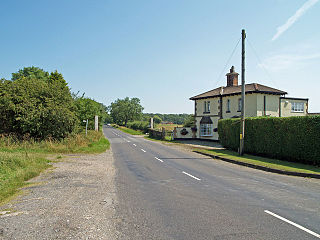
The Lincolnshire Wolds Railway (LWR) is a heritage railway based at Ludborough station, near Louth, Lincolnshire, England and the only standard gauge steam railway in Lincolnshire open to the public. The line is part of the original Great Northern Railway (GNR), a rail system that opened in 1848 and once linked Grimsby, Louth and East Lincolnshire with London. In early 2002, 2009 and 2013 the Lincolnshire Wolds Railway received a top national award from the Heritage Railway Association for its heritage railway efforts.

The Grimsby & Immingham Electric Railway (G&IER) was an electric light railway, primarily for passenger traffic, linking Great Grimsby with the Port of Immingham in Lincolnshire, England. The line was built by the Great Central Railway (GCR), was absorbed by the London & North Eastern Railway (LNER) in 1923, and became part of the Eastern Region of British Railways. It ran mainly on reserved track.

Immingham engine shed, also known as Immingham depot, or more recently as Immingham TMD and always locally as Loco is a railway maintenance depot located on the Immingham Dock estate, in North East Lincolnshire, England. The depot code is IM.

Ludborough is a heritage railway station in Ludborough, Lincolnshire, England, which is the base of the Lincolnshire Wolds Railway. The station, which was previously part of the East Lincolnshire Railway, closed in 1961 to passengers and 1964 to freight, but was taken over by the preservation society in 1984. The first trains from the station to North Thoresby, to the north, ran in August 2009, the first for 47 years. There are proposals to extend the line further in both directions towards Holton-le-Clay and Louth.

Holton-le-Clay was a railway station on the East Lincolnshire Railway which served the English villages of Holton-le-Clay and Tetney in Lincolnshire between 1848 and 1964. It was originally named Holton-le-Clay and Tetney, but Tetney was dropped soon after opening, even though the station was more conveniently sited for that village. The line through Holton-le-Clay remained open for freight until December 1980, but could be reopened by the Lincolnshire Wolds Railway as its northern terminus.

North Thoresby is a heritage railway station in North Thoresby, Lincolnshire. The station, which was previously part of the East Lincolnshire Railway, closed in 1970, but has since been reopened by the Lincolnshire Wolds Railway. The first services to the station from Ludborough, to the south, ran in August 2009, the first in 47 years. The LWR aims to extend the line further in both directions, northwards as far as Holton-Le-Clay and southwards to Louth.
East Halton railway station was located on Skitter Road north of East Halton, Lincolnshire, England.
Killingholme railway station was located on Killingholme Marsh in the parish of South Killingholme, Lincolnshire, equidistant from the villages of North and South Killingholme.

Immingham Dock railway station served the dock at Immingham, Lincolnshire, England.

Immingham Town electric railway station was the penultimate unconditional stop on the inter-urban Grimsby and Immingham Electric Railway when travelling from Corporation Bridge, Grimsby to Immingham Dock. All tramcars reversed here.
Grimsby electric railway station was the eastern terminus of the Grimsby and Immingham Electric Railway, the western terminus being Immingham Dock, 7 miles (11 km) to the north west.
Immingham electric railway station would have been a halt on the Grimsby and Immingham Electric Railway, but it never opened to fare paying passengers. Electrified track was laid to the station site and quarterly proving cars ran for nearly twentyfive years, but no revenue-earning car ever travelled to or from the halt.

New Holland Pier railway station is a former railway terminus in North Lincolnshire, England. It stood at the seaward end of the New Holland Pier, which juts 1,375 feet (419 m) northwards into the River Humber at the village of New Holland. Its purpose was to enable railway passengers, vehicles and goods to transfer to and from ferries plying between New Holland and Hull.

Grainsby Halt was a railway halt on the East Lincolnshire Railway which served the hamlet of Grainsby in Lincolnshire between 1905 and 1952. The station, which opened as part of a new motor train service between Grimsby and Louth, was opened to serve a Victorian hall situated 2 miles (3.2 km) to the west. The station, one of the smallest to be taken over by British Railways on nationalisation in 1947, never really justified its existence and closed in 1952 following a period of temporary closure during the Second World War. The line through Grainsby remained open for freight until December 1980.

Killingholme Admiralty Platform railway station, known locally as Admiralty Platform, was near North Killingholme Haven, Lincolnshire, England.
The Barton and Immingham Light Railway was a light railway in North and North East Lincolnshire. It was later absorbed by the Great Central Railway and later, on grouping, it passed to the London and North Eastern Railway. The railway is now mostly closed.
Immingham Western Jetty railway station was a temporary structure which served the dock in Immingham, Lincolnshire, England.
New Holland Town railway station is a former railway station in the village of New Holland in North Lincolnshire, England. It stood at the landward end of the pier, whilst the purpose of Pier station, which was juts 1,375 feet (419 m) northwards into the River Humber, was to enable railway passengers and goods to transfer to and from ferries plying between New Holland and Hull. New Holland Town station's purpose was for more conventional use by the local community.
Grimsby engine shed was a railway locomotive maintenance depot located southeast of Grimsby Docks station in North East Lincolnshire.
Grimsby Pyewipe Road railway station was a temporary terminus serving people involved in building Immingham Dock, Lincolnshire, England.











